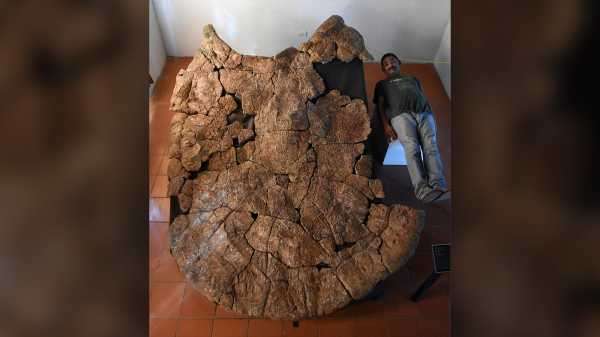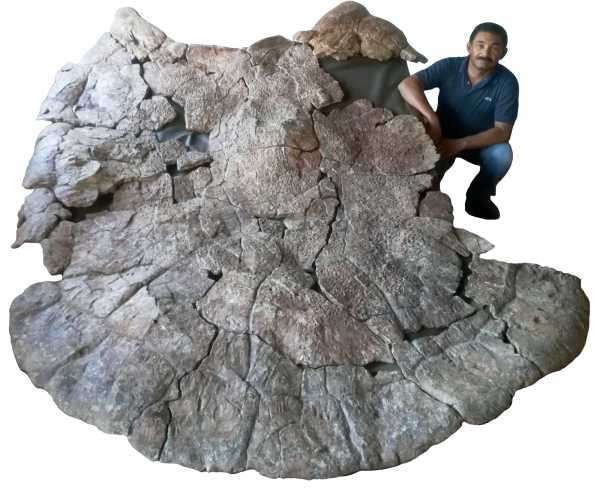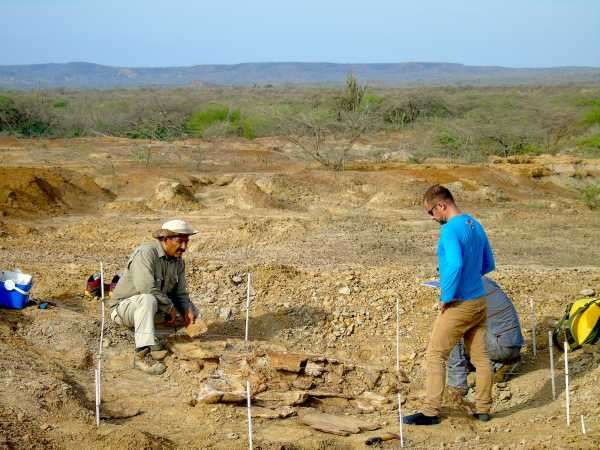
An illustration of a giant male (front) and female (left) Stupendemys geographicus out swimming for a snack.
An 8-million-year-old turtle shell unearthed in Venezuela measures nearly 8 feet (2.4 meters) long, making it the largest complete turtle shell known to science, a new study reported.
This shell belonged to an extinct beast called Stupendemys geographicus, which lived in northern South America during the Miocene epoch, which lasted from 12 million to 5 million years ago.
.
The species likely achieved its colossal size thanks to the warm wetlands and lakes in its habitat, Sánchez noted.
Image 1 of 6

Study lead researcher Edwin Cadena, an associate professor of paleontology at Universidad del Rosario in Colombia, examines one of the Stupendemys geographicus male turtle shells during a dig in 2016. Image 2 of 6

Rodolfo Sánchez showcases the turtle shell of the huge Stupendemys geographicus, which lived about 8 million years ago in northern South America. Image 3 of 6

Study co-researcher Rodolfo Sánchez, a paleontologist at the Urumaco Paleontological Museum in Venezuela, collects data near where the fossils were discovered. Image 4 of 6

Rodolfo Sánchez (left) and Edwin Cadena (right) work together to excavate the enormous turtle fossils found in northern Venezuela. Image 5 of 6

Edwin Cadena, Jaime Chirinos Image 6 of 6

Study lead researcher Edwin Cadena, an associate professor of paleontology at Universidad del Rosario in Colombia, examines one of the Stupendemys geographicus male turtle shells during a dig in 2016.
Scientists have known about the colossal S. geographicus since 1976, but the new investigation uncovered even more fossils and secrets about this poorly understood turtle. For instance, large caimans (a type of crocodile) chomped down on S. geographicus shells, and S. geographicus males had horned shells.
Included in the study were shells and the first known lower jaws of these turtles, which came from a 1994 dig in Venezuela’s Urumaco region, as well as new finds from the La Tatacoa Desert in Colombia. After examining these fossils, the researchers realized that the male turtles had unique, horn-like weapons at the front of their carapaces, or upper shells.
These horns were likely used as weapons in male-to-male combat, the researchers said. Similar combative behavior is seen today in snapping turtles (Chelydridae), whose males often fight each other to establish dominance in overlapping territories, the researchers said.
An “elongated and deep scar in the left horn” of one of the S. geographicus shells could be a mark from combat between males, the researchers added.
A lone caiman tooth protruded from another shell, suggesting that, though these turtles were large, lurking predators still hunted them, the researchers said.
The study was published online Wednesday (Feb. 12) in the journal Science Advances.
- In photos: Tagging baby sea turtles
- Amazing journey: World-traveling sea turtle goes home
- Image gallery: 25 amazing ancient beasts
Originally published on Live Science.
Sourse: www.livescience.com





